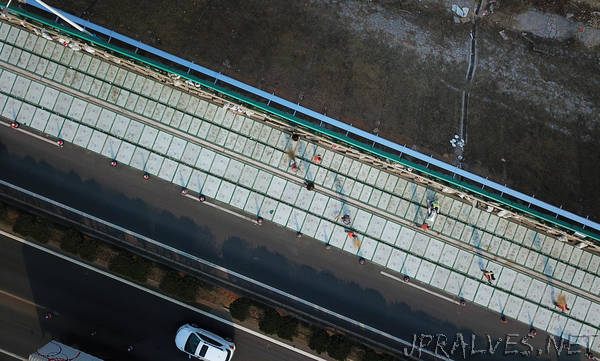
“Jinan South Ring Expressway will become the first freeway in the world to carry photovoltaic research and development and laying. The electricity generated from photovoltaic pavement is connected with the charging pile. In the future, it may also be possible to charge and move vehicles so that photovoltaic pavement becomes the “flow of electric vehicles power Bank”.
Last December, the French construction company Colas, for the first time, implemented a 1-kilometer photovoltaic road laying on the secondary road through the French city of Tourouvre au Perche in Normandy and is expected to supply the town’s street light with 3,400 inhabitants Adequate electricity.
The photovoltaic pavement in France covers an area of 2,800 square meters and is located on a lane of a local bi-directional two-lane highway
Nowadays, “Black Technology”, a deep integration of the photovoltaic road and transportation industry with the new energy industry, has come to China just like all China’s infrastructure projects in the past, involving a larger scale and a faster completion speed. By the end of 2017, Jinan South Ring Expressway will become the first expressway in the world to carry photovoltaic research and development. The picture below is taken in the morning of November 30, Jinan South Ring Expressway construction workers are still in full swing laying photovoltaic pavement.
Transparent concrete vehicles under the unobstructed pavement PV modules have been connected to the grid
The technology used in this pavement is called as bearing photovoltaic pavement technology. The photovoltaic power generation components that meet the traffic conditions of vehicles are directly laid on the pavement of the road. The pavement surface layer is called “transparent concrete”, and its technical index and traffic safety factor exceed Currently used asphalt concrete pavement.
Photovoltaic power modules and solar panels function the same, but to meet the road use, enhanced compression, anti-skid performance. Photovoltaic pavement can not only carry small electric vehicles, but also can carry medium-sized trucks, vehicles traveling on the photovoltaic road and ordinary asphalt pavement can not be significantly different.
Said that at present the road has been achieved grid-connected power generation, that is to say, this photovoltaic power generation has been connected with the charging pile. When interviewed by CCTV reporter Zhang Hongchao, a professor of Tongji University School of Transportation Engineering that provides the core technology of photovoltaic pavement, said: “The photovoltaic pavement transforms the collected solar energy into electric energy so as to realize solar power generation.”
The costs are still very high in the future or will be charged back through the mobile charging of electric vehicles
When the French photovoltaic road was opened to traffic, the most eye-catching figures are still the high cost of building this road. Just this photovoltaic road covering one kilometer of a single lane pavement, it cost 5000000 euros (about 40 million yuan).
Because it is tiled along the pavement, the photovoltaic efficiency of this highway in France is only 15%, while the photovoltaic efficiency set on the roof of a home can often reach about 20%
At the time, the French Minister of Ecology, Segolene Royal, said that in the future, it is hoped that 1 km of 1,000 km of French highways will be covered by photovoltaic road surface. Assuming her project is to achieve two-way single lane coverage, the cost may be as high as 10 billion euros RMB).
Jinan South Ring Expressway project total investment and long-term funding has not yet announced, but from the current picture of the photovoltaic coverage of a single lane and next to the emergency parking zone, the cost per kilometer probably higher than the French project.
The hope of recovering the cost of photovoltaic pavement is the potential of becoming the “mobile charging treasure” of electric vehicles in the future. At present, the wireless charging technology for electric vehicles is relatively mature. In 2013, the world’s first wireless charging bus lane was built in Korea. On May 18, this year, Qualcomm has realized wireless charging at an electric vehicle speed of 100km / h.
In the above CCTV report, Zhang Hongchao said that through the convergence with the technology of electric vehicles, the photovoltaic pavement can realize vehicle mobile charging and the motorway network all over the country will become a mobile “solar charging treasure.” Photovoltaic smart roads can also detect the road icing conditions in real time through the icy road detection system, thus automatically turning on the electric heating system, removing ice and snow on the road in time, and ensuring travel safety.”
